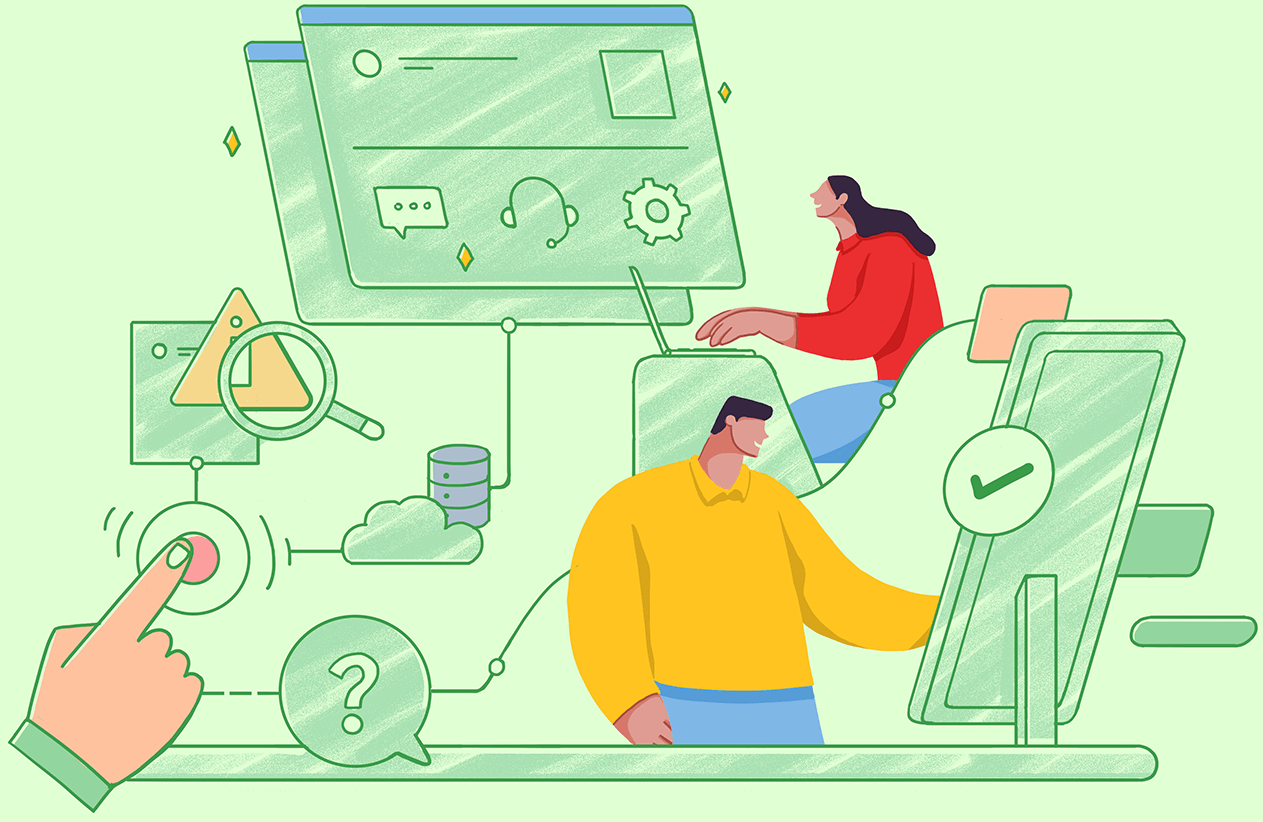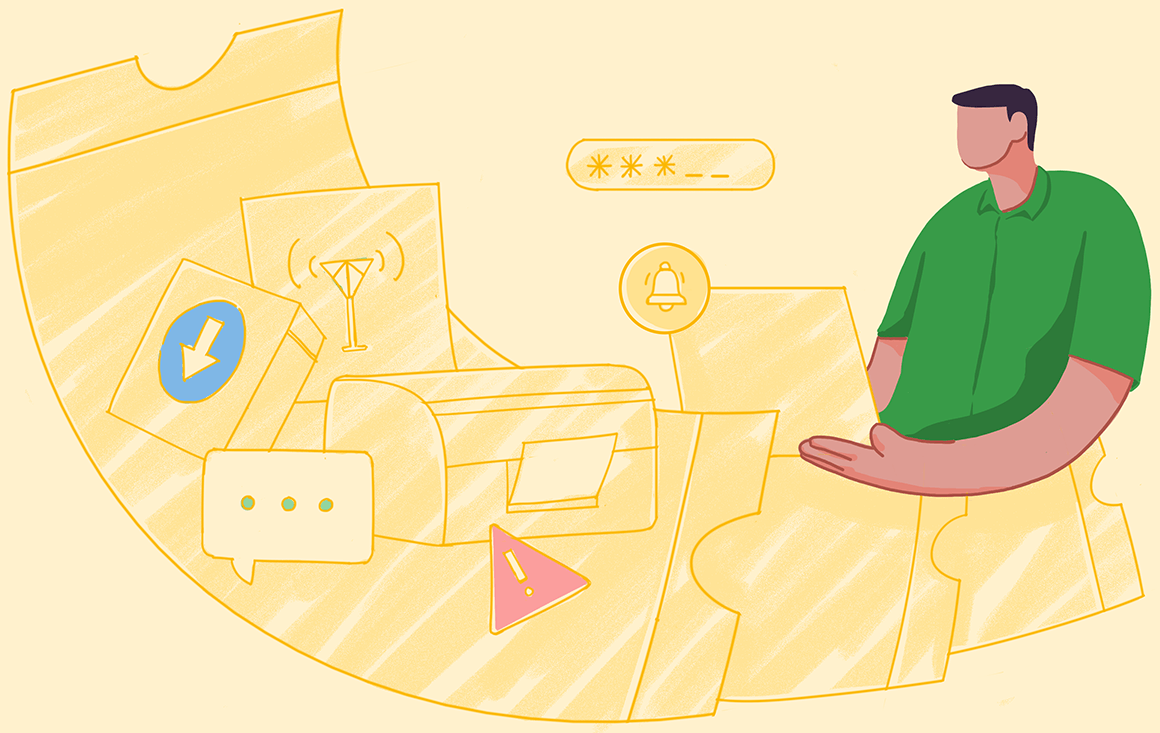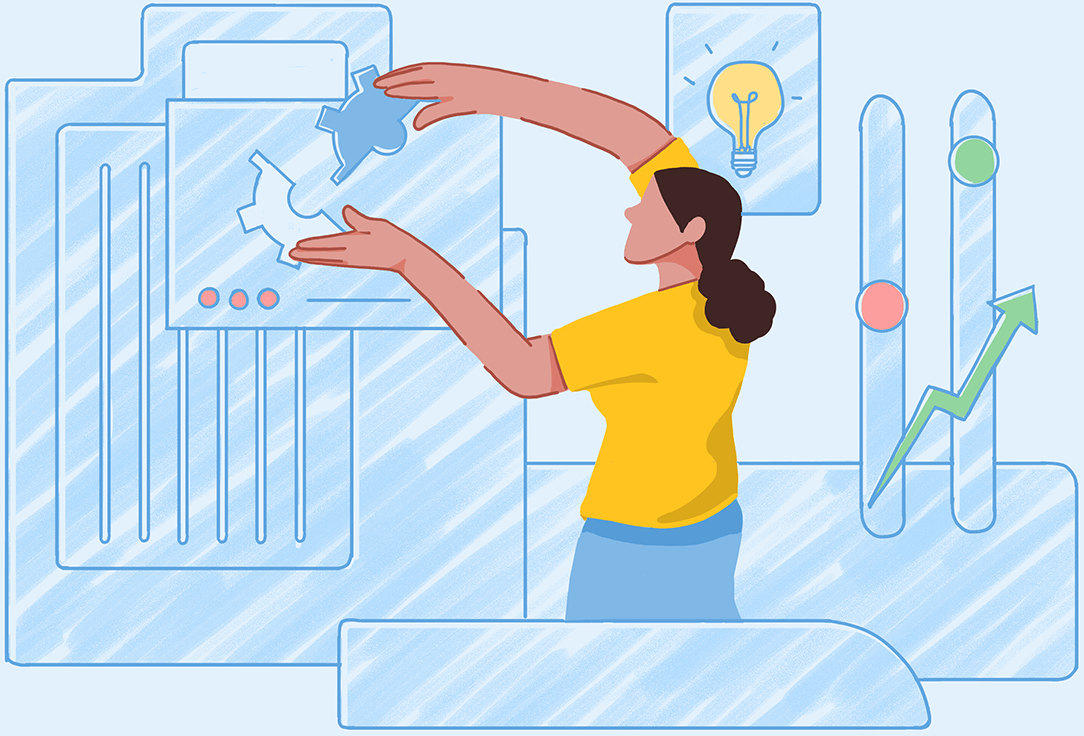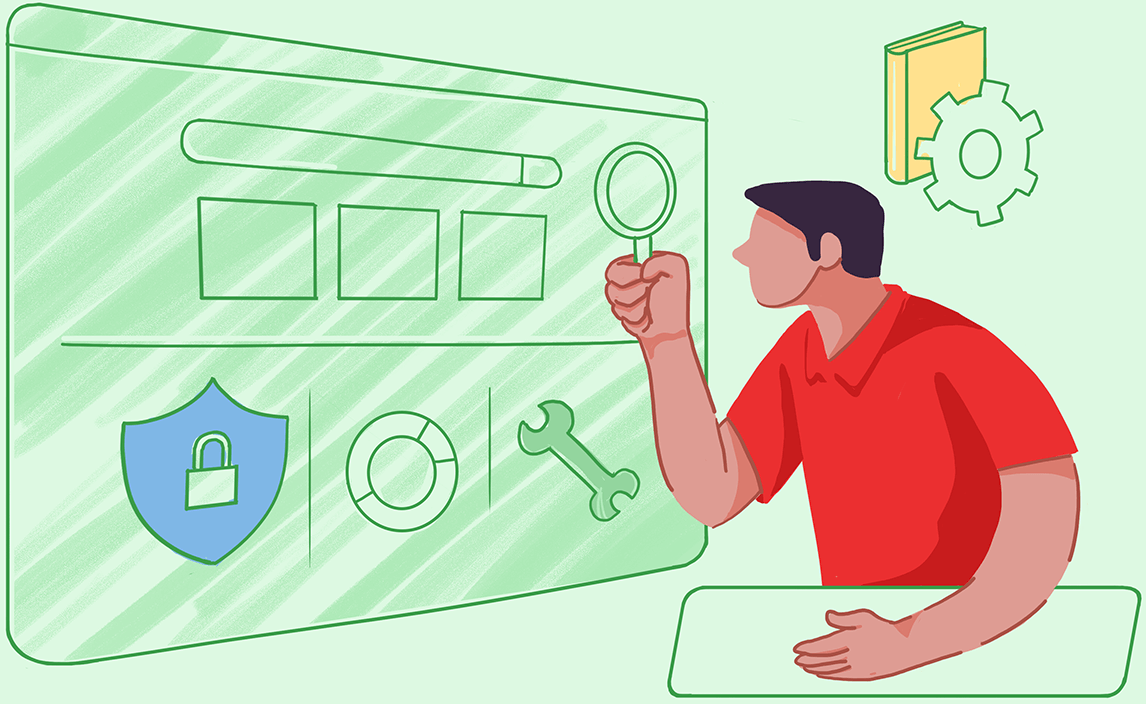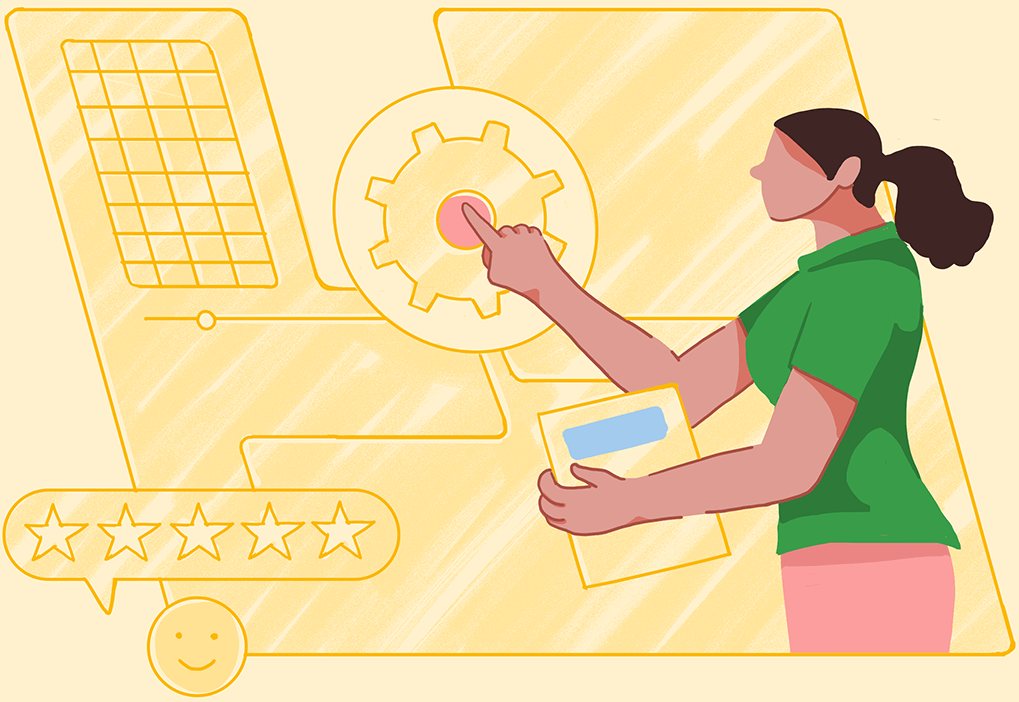A well-designed self-service portal can significantly enhance the efficiency of the IT service desk team by enabling end users to resolve issues independently—without requiring the intervention of a technician. This not only reduces the workload on the IT service desk team but also frees up their time to focus on more complex tasks and strategic initiatives. However, if not properly designed and implemented, the adoption of a self-service portal may not meet end user expectations.
According to a Harvard Business Review, about 81% of people try to solve their issues independently before reaching out to support agents.
Self-service empowers end users to solve IT related issues or requests on their own, without the assistance of an IT service desk technician. It enables end users to handle simple L1 tickets—such as resetting passwords, installing software, resolving WiFi connectivity issues, setting up printers, and other common issues—through access to relevant knowledge articles, FAQs, troubleshooting guides, and chatbots.
Self-service portals come in two types: those designed for customers and those designed for employees.
- Customer self-service portals: These portals serve as a convenient resource for customers. Hosted on the company’s website, this portal is available around the clock. It typically contains knowledge base articles, FAQs, chat services, tutorials, community forums, and other relevant options for problem-solving.
- Employee self-service (ESS) portals: The ESS portal is designed for internal use and is accessible online 24/7 to employees of the organization. Employees must log in to access the portal using
either dedicated login credentials or using SAML SSO. Similar to customer portals, it offers resources and solutions for common IT issues. Organizations can develop two types of ESS portals based on their business
and process requirements:
- The conventional approach involves hosting separate self-service portals for each department in the organization, such as IT, HR, facilities, and so on.
- The unified approach involves a single enterprise self-service portal that provides access to multiple departments within the organization, including IT, HR, legal, and beyond. An example of an enterprise self-service portal is depicted in Figure 1.
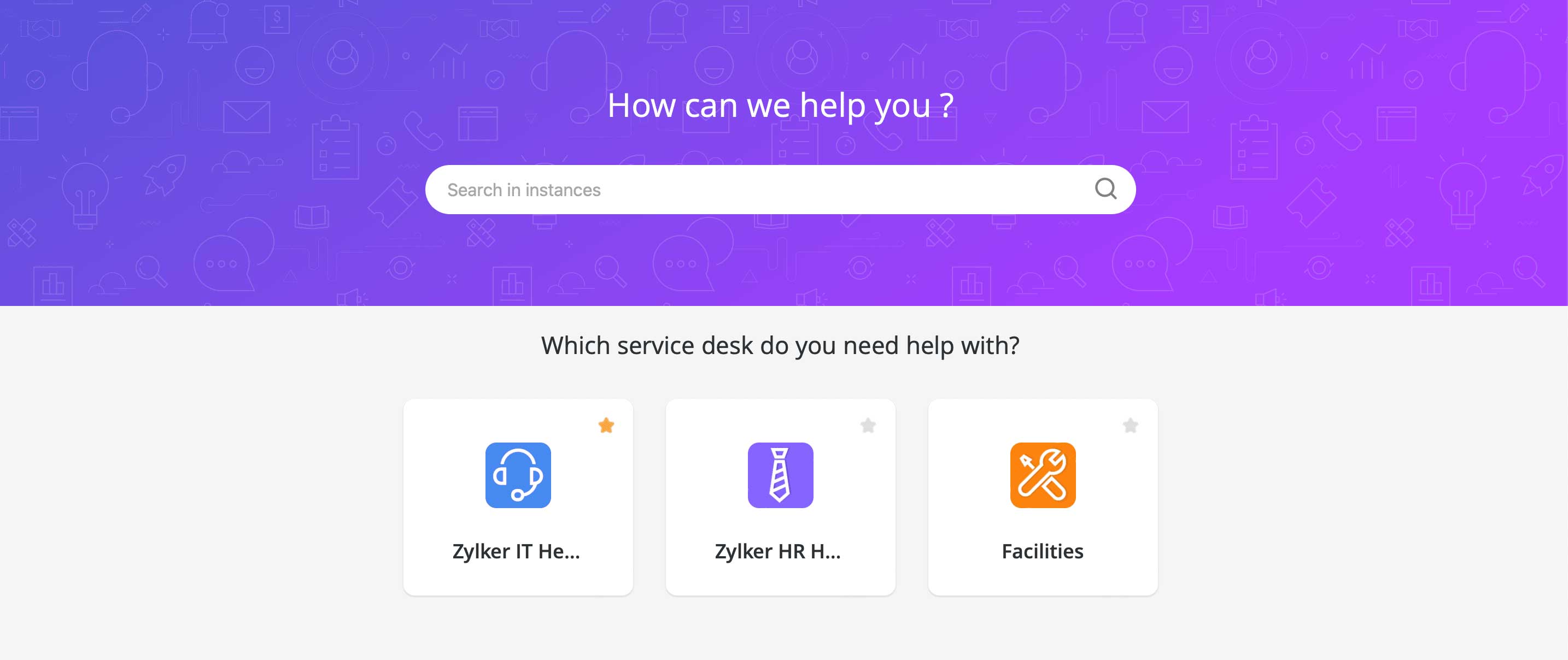
Figure 1: Enterprise self-service portal
- Minimizes the ticket volume: End users can readily access solutions and answers without relying on support agents, offering significant time savings for both end users and support agents. This, in turn, reduces the volume of support tickets for minor issues, enabling support agents to focus on critical issues and strategic projects.
- Operates round the clock: Self-service support is available 24/7 and can be accessed from anywhere, at any time, according to the convenience of end users.
- Optimizes IT budgets: The reduction of L1 tickets—coupled with an increased focus on strategic IT goals—helps IT leaders optimize resource allocations that translate directly into cost savings.
It saves time
It minimizes ticket influx
It’s available 24/7
It saves your financial resources
By following these best practices, you can create a self-service portal that is truly user friendly, helpful, and serves as a proactive, first line of IT support.
- User-centric design: Design the self-service portal with the end user in mind. Ensure the interface is intuitive, user friendly, and accessible across various devices. Simplify navigation and use language
that is easily understandable by all users. Please see Figure 2 for an example of an employee IT self-service portal.
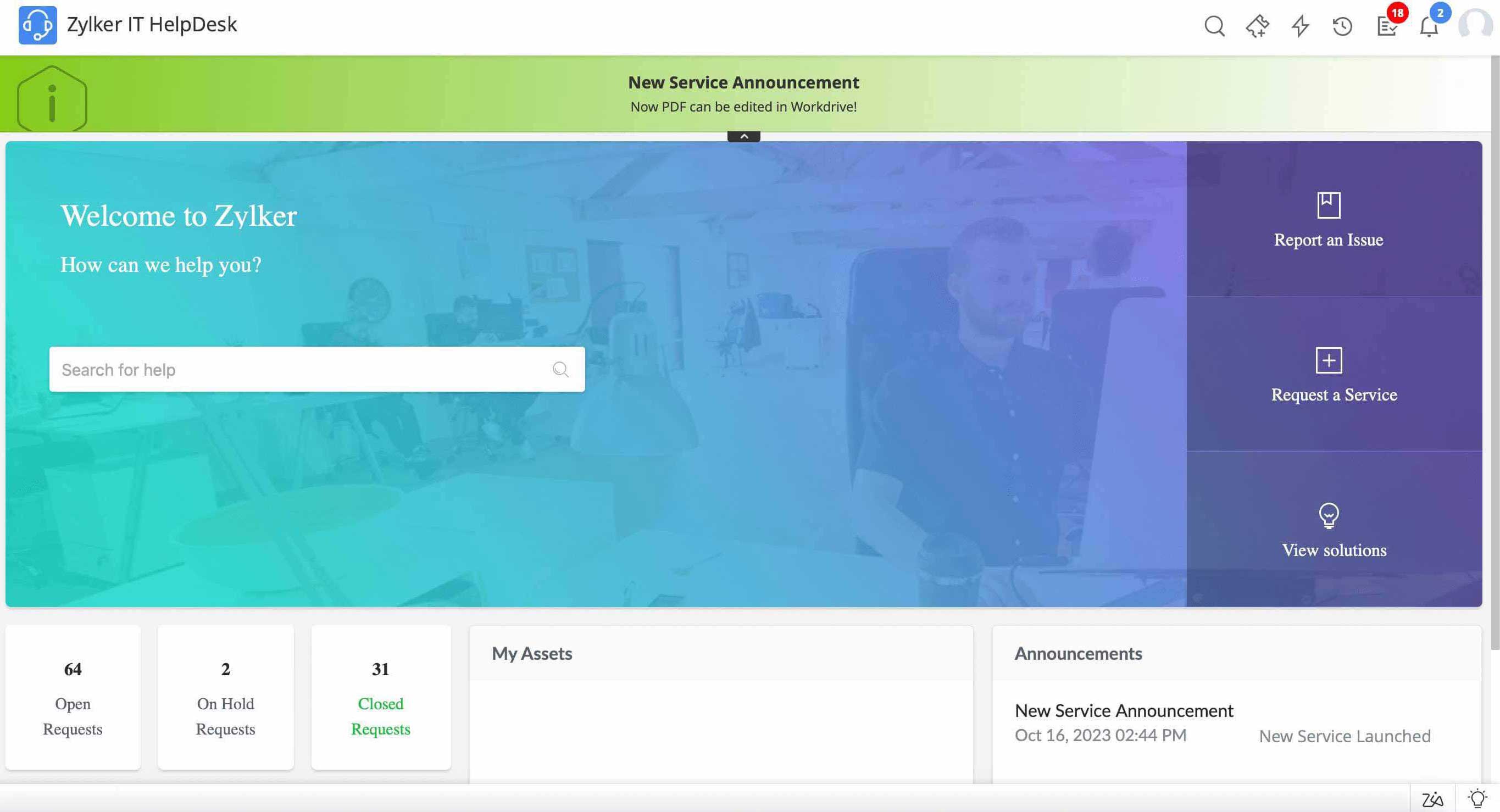
Figure 2: Example of an employee IT self-service portal
- Design a service catalog: Streamline your organization's service catalog (Figure 3) to become the ultimate one-stop destination. Customize the catalog to gather and display a personalized array of services for employees based on their roles and responsibilities. Make it easy for the
employees to browse and select what they need, just like shopping online.
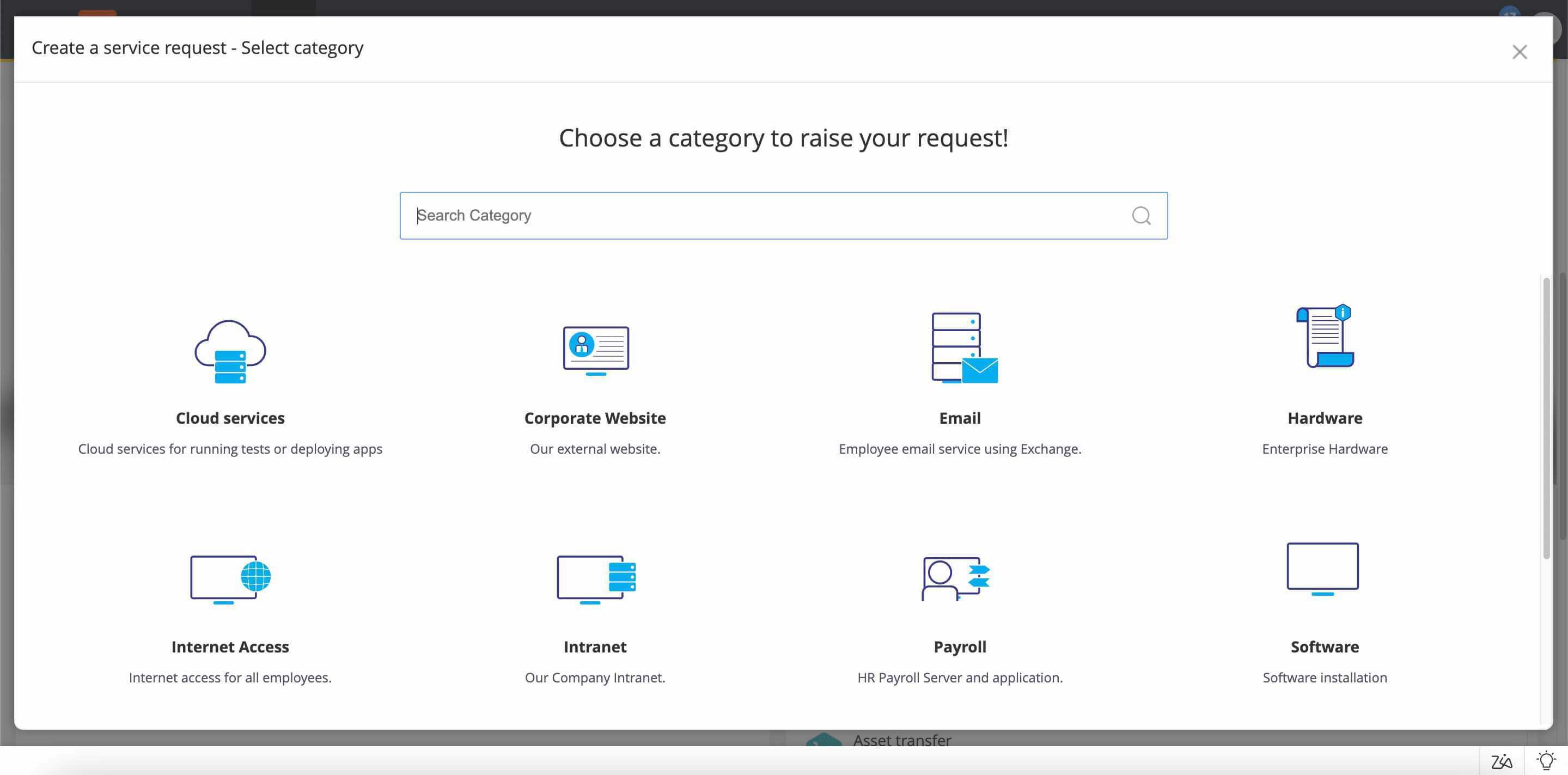
Figure 3: Illustration of a service catalog
- Robust knowledge management: Populate the portal with a comprehensive knowledge base (Figure 4) that includes FAQs, troubleshooting guides, how-to articles, and video tutorials. Ensure that the
knowledge base is regularly updated with accurate and relevant information to address common user queries and issues.
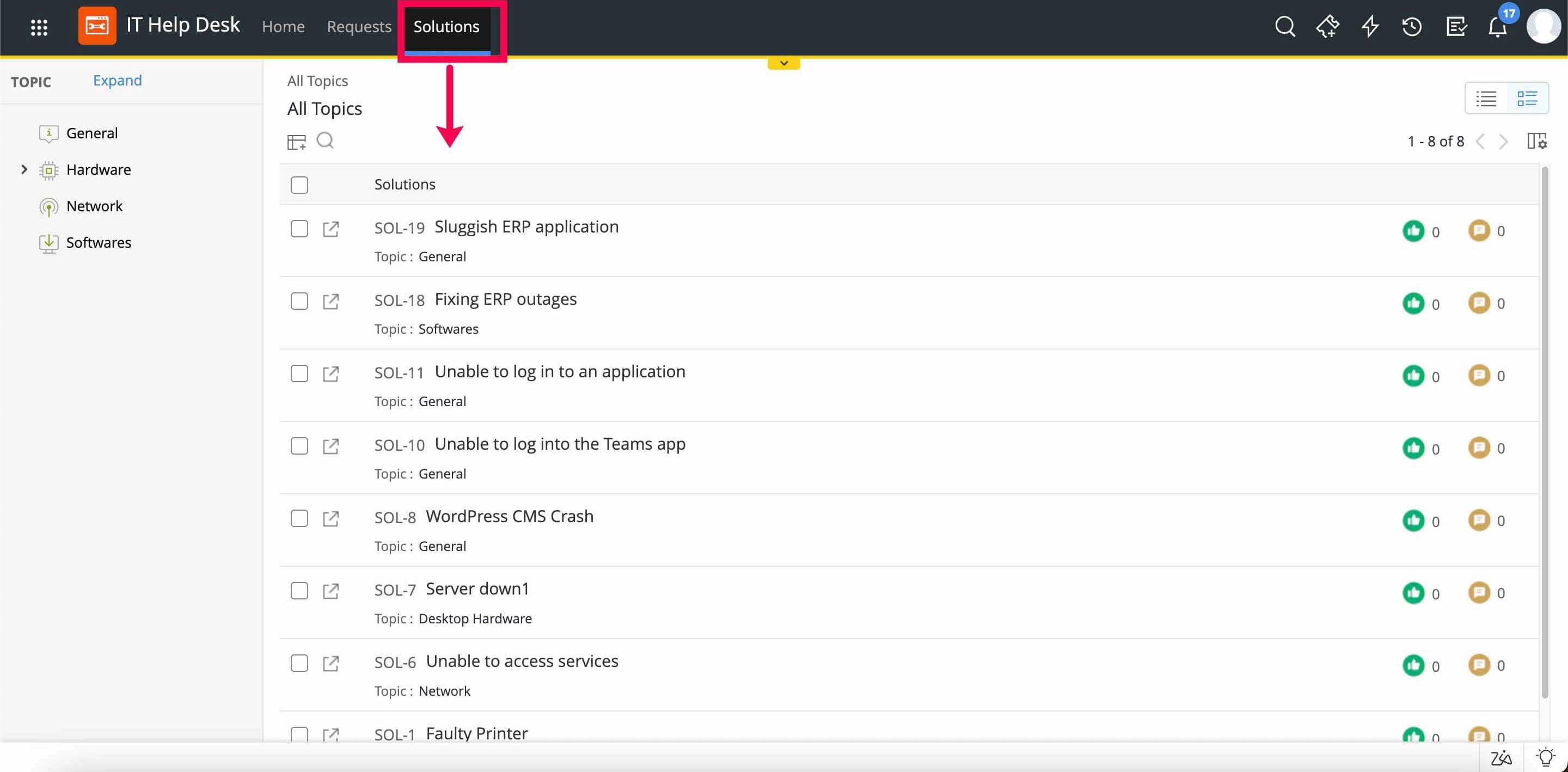
Figure 4: Knowledge base repository
- Round-the-clock assistance: Leverage the power of an AI-powered chatbot and virtual agent, available around the clock to engage with end users and offer assistance. Through contextual understanding,
it can converse with end users, suggesting relevant knowledge articles or creating tickets as needed. Figure 5 depicts Zia, the AI-powered chatbot integrated with ServiceDesk Plus.

Figure 5: Zia—the AI-driven chatbot featured in ServiceDesk Plus
- Automation: Automate typical routine tasks to decrease the burden on IT support agents. Automating common L1 tasks (Figure 6) such as password resets, software installations, printer issues, and VPN
issues can significantly boost productivity for both end users and IT support agents.

Figure 6: Workflow for automating L1 tasks
- User survey: Implement a feedback mechanism enabling users to share input on the helpfulness and relevance of articles and the self-service portal (Figure 7). Use this feedback to identify areas for
enhancement and implement improvements to enhance the portal's performance and usability progressively.
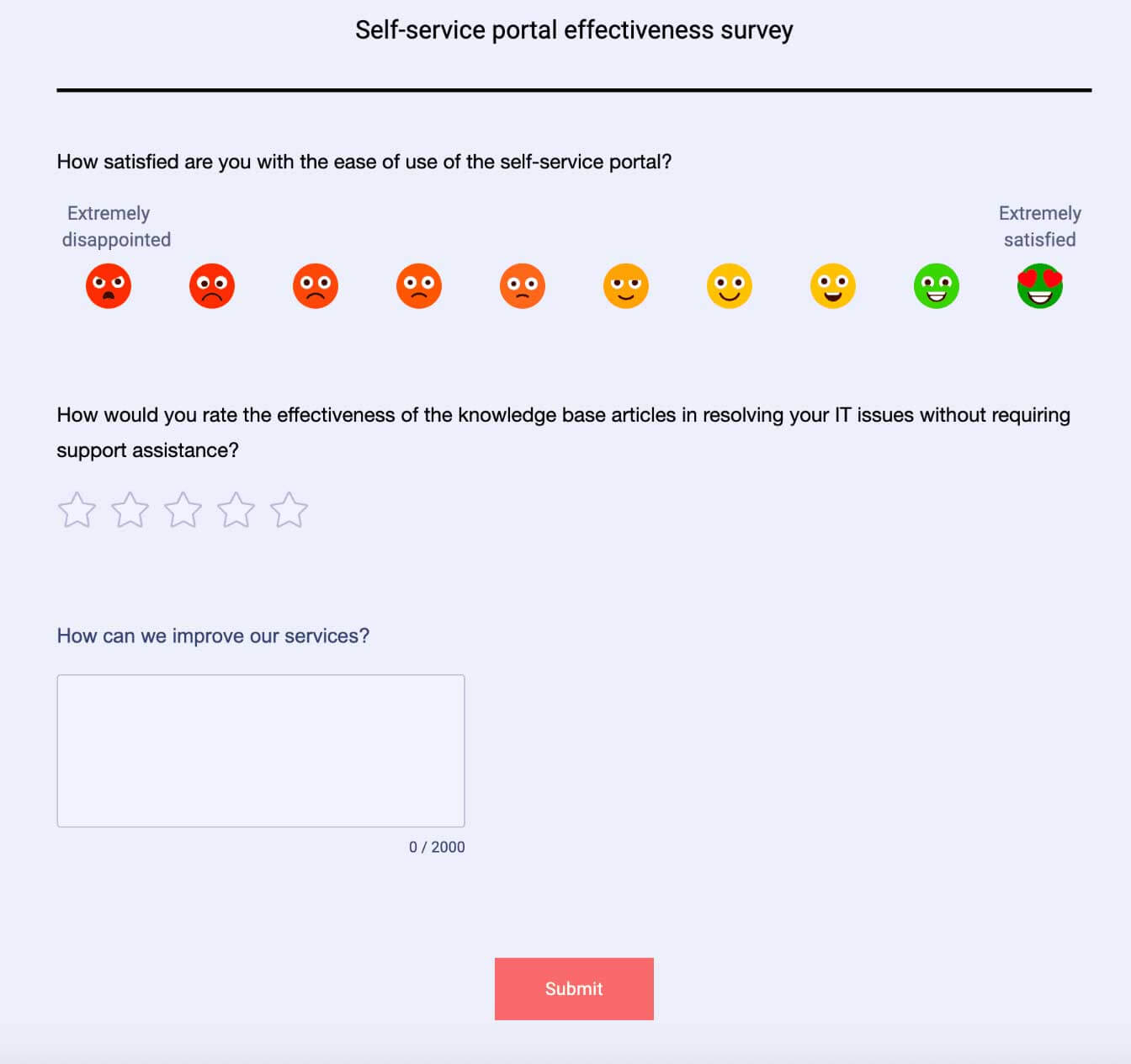
Figure 7: Employee feedback survey
- Design a robust self-service portal: A home page that provides a preview of the relevant content ensures end users quickly grasp what awaits them. Featuring FAQs, troubleshooting tips, and step-by-step instructions, the portal should deliver accessible and comprehensible information. The portal should allow the end users to view and select available services, browse templates for reporting issues, access announcements and knowledge base articles, track the status of their tickets from creation to closure, and more.
- Build a service catalog: The service catalog serves as your organization's central hub for meeting end-user requirements across departments. Categorize the services offered; providing an e-commerce-like interface makes it simple for end users to select the resources they require, offering them a familiar and user-friendly experience.
- Make the right information available with knowledge base articles: Crafting effective knowledge-base articles goes a long way in helping end users resolve issues by themselves. Organize content logically, use clear language, and address common user queries. For technicians, create specific roles and groups based on the field of expertise and share only relevant articles they are authorized to view. Regularly update articles to reflect changes and maintain accuracy.
- Revitalize your self-service portal: Take advantage of customization features to align the portal's look with your organization's branding and preferences. Enhance usability and productivity by consolidating knowledge from various sources into widgets in one central location. These widgets can include announcements, ticket summaries, frequently accessed knowledge base articles, upcoming maintenance notifications, relevant third-party websites, and more.
- Spread the word: Once your portal is operational, it's essential to spread the word far and wide. Ensure that everyone within your organization is aware of its existence and can easily navigate through it. Utilize various communication channels—such as email announcements, newsletters, and internal forums—to promote the portal. Additionally, provide clear instructions and guidance on how to access and use the portal effectively. By actively promoting and encouraging adoption, you can maximize the portal's utilization and effectiveness across your organization.
Spur self-service portal adoption with the ServiceDesk Plus launch pack, tailored to promote your organization's self-service options!
Figure 8 presents an illustration of an employee IT self-service portal, highlighting key functionalities such as a search bar, widgets, and other self-service options.
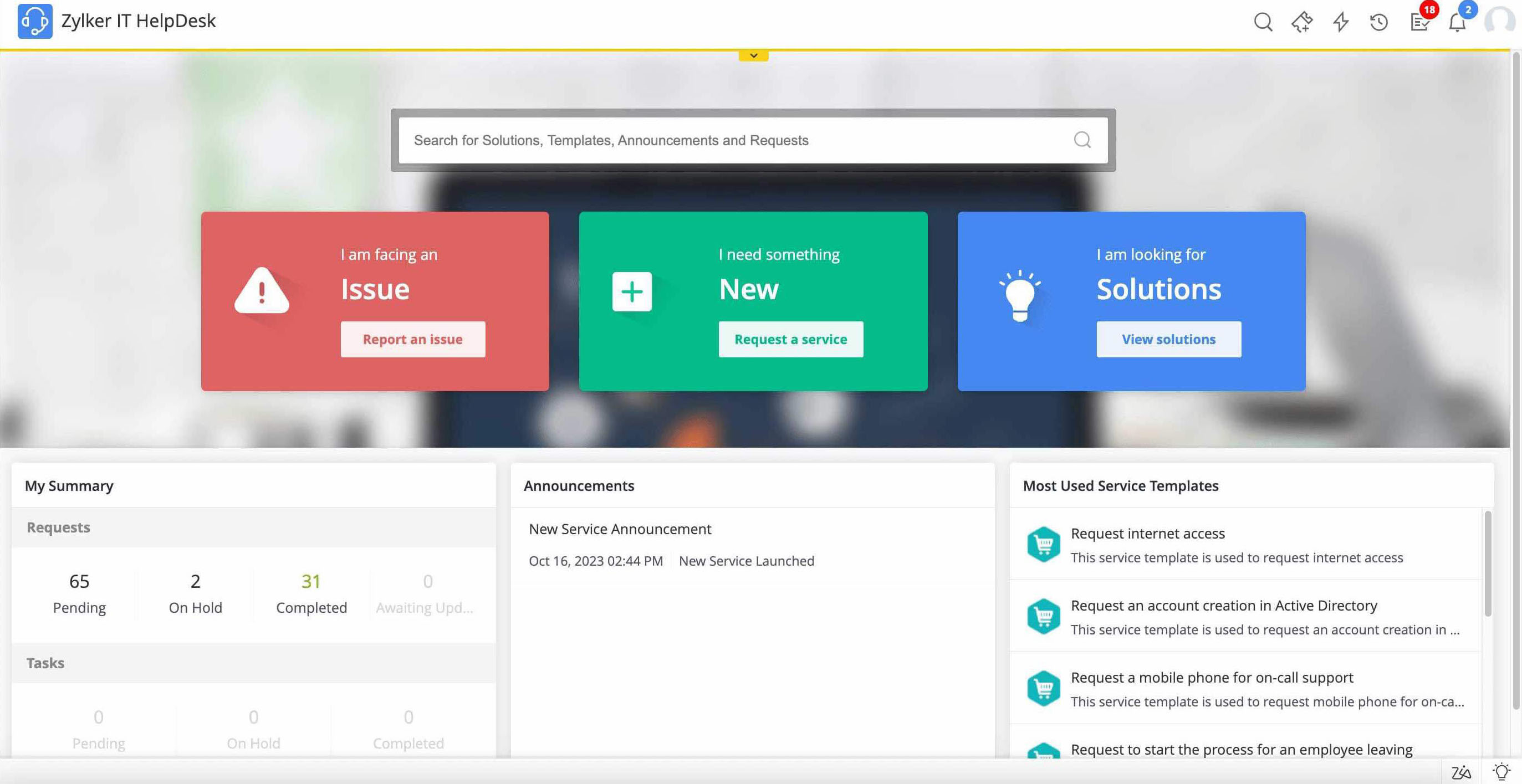
Figure 8: Employee IT self-service portal
Adopting a self-service portal can bring numerous benefits, but it also presents several challenges for organizations.
- User adoption: Ensuring widespread acceptance of the self-service portal among employees might be difficult. Organizations must spend significant time and effort on user training, communication, and change management strategies to encourage users to adopt the new system.
- Portal design: Creating an intuitive and user-friendly interface is critical to the success of a self-service portal. If the portal is difficult to use or lacks relevant information, users may feel dissatisfied and turn to traditional support channels.
- Content management: Maintaining an up-to-date knowledge base and service catalog requires ongoing effort and coordination among various stakeholders. Outdated or inaccurate information can erode user trust and confidence in the portal.
- Measuring success: Assessing the portal's impact on user satisfaction and productivity requires both qualitative and quantitative feedback, which can be subjective and time-consuming to gather. Additionally, determining the portal's effectiveness may be complex due to factors like varying levels of user adoption and the integration of multiple systems.
When selecting a self-service portal solution, there are several key factors to consider to ensure that it meets your organization's needs effectively. The effectiveness of your self-service portal depends on the quality of information and features you offer. Here are some essential features to consider for your self-service portal to enhance usability, accessibility, and user satisfaction.
- User interface and accessibility: Find a software solution with a user-friendly interface that allows you to customize the portal's appearance to match your brand identity and tailor it to your specific requirements. The portal should be accessible across various devices and platforms, including desktops, laptops, tablets, and smartphones.
- Searchability and navigation: Seek a solution where the search functionality allows users to quickly find relevant information by scanning through articles, FAQs, and guides. Intuitive navigation allows users to easily browse IT services, prefilled forms, and articles, facilitating seamless exploration. Clear labeling and tagging ensure easy access to information, aiding navigation and search. Additionally, providing links to all support channels accommodates varied user preferences.
- Integrations and AI: Choose a solution that seamlessly integrates with existing systems like asset management and request fulfillment, ensuring smooth data flow. Additionally, it should be complemented by AI-powered chatbots or virtual assistants for personalized assistance on demand.
- IT and enterprise ticketing: Look for a tool that empower end users to conveniently submit, track, and manage their IT requests and issues, along with requests for other departments within the organization, all from a single platform.
- Reporting and dashboards: Make certain that the self-service solution includes reports and dashboards to monitor key metrics such as number of users accessing the portal, percentage of issues resolved through self-service, number of conversations with the chatbot, user satisfaction score, percentage of self-service interactions resulting in formal ticket creation, usage and engagement metrics for knowledge base articles, and more. This facilitates trend identification, effectiveness measurement, and areas for improvement within the portal.
- Security and compliance: Verify that the software adheres to security best practices like data encryption and access permissions. The solution should comply with relevant industry standards and regulations.
- Support and training: Assess the level of support and training provided by the software vendor to assist with implementation, onboarding, and ongoing maintenance of the self-service portal. Take advantage of free trials and demos to test the software's functionality and suitability. This can help you understand how well it fits your requirements.
ServiceDesk Plus comes packed with an intuitive self-service portal, ensuring seamless navigation and resource accessibility for all users. Organizations can leverage ServiceDesk Plus to present their IT service catalog, streamlining service selection.
Zia, the native AI-powered conversational assistant, helps end-users resolve issues by themselves or raise a ticket wherever technician intervention is needed. It also integrates with ChatGPT, enabling end users to lean on GenAI for resolving their IT issues.
Native enterprise service management capabilities, coupled with unrestricted extensibility via low-code scripting, empower organizations to design, deliver, and support business and IT services across their organization.
Sign up today for a 30-day free trial!

